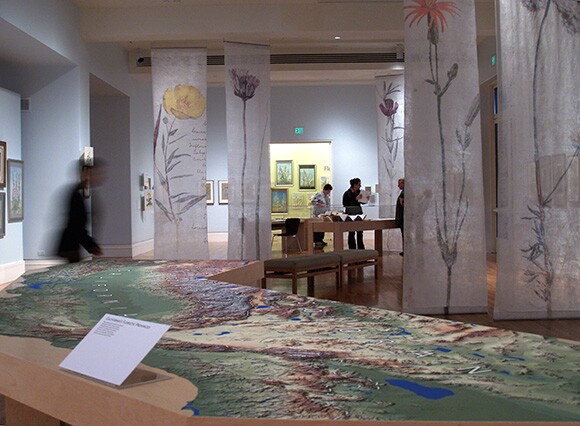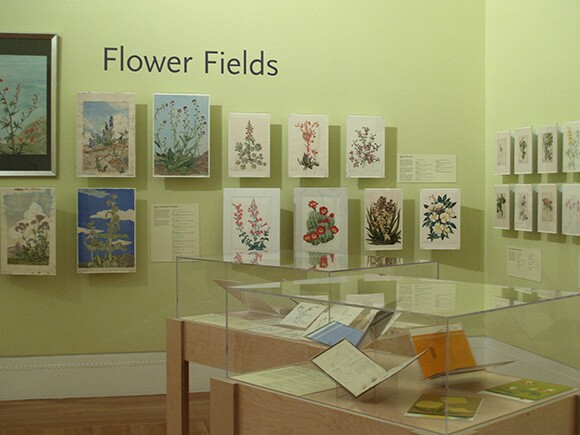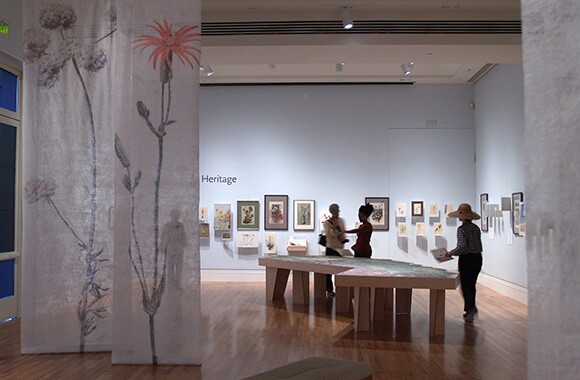Savage Flowers and the Wild California Dream

Thought-provoking and beautifully designed, the Huntington Library, Art Collections, and Botanical Gardens' When They Were Wild: Recapturing California's Wildflower Heritage exhibition is framed by its complex context. In 2015 the Huntington's beloved Chinese, Japanese, Shakespeare, and Rose Gardens will be augmented by, if not precisely a named Native Garden, significant native plant-focus around a new Education and Visitor Center.
On the one hand "When They Were Wild: Recapturing California's Wildflower Heritage," is an exhibition about the native flowers of California. It draws on botanical illustrations from three collections -- those of The Huntington, the Theodore Payne Foundation, and Rancho Santa Ana Botanic Garden -- to "trace the journey of California's plants from the flower fields to home gardens," and everything about its content and design points, most pointedly, to the physical matter of flowers.
But on the other hand, is it really possible to juxtapose "Wild" and "California" in an exhibition title, or trace a journey from wildness to cultivation, without summoning the mythical "Wild West" frontier between savagery and civilization? Or bumping into thestill-popular fiction that California was once a bountiful but unworked wilderness inhabited by "lazy savages"?
In contrast to, for example, "The West of the Imagination," a book about the ways in which "visual image-makers have contributed to the fundamental myth of the American experience," "When They Were Wild" looks to those image-makers who collected, scrutinized, and depicted the real flowers of the continent's western edge, one of the most diverse floras in the world.

Instead ofFrederick Remington's dashing cowboys and Albert Bierstadt's monumental landscapes, "When They Were Wild" looks to a delicate Beach Sand Verbena painted by schoolteacher Clara Mason Fox (1873-1959), who identified over two hundred plant species in Orange County's Silverado Canyon; and a Pink Mallow by Alice Brown Chittenden (1859-1944), a "type specimen" -- the original on which new species descriptions are based -- that she found and painted in 1917.
Exampling art in the service of science rather than aesthetics or myth -- though influenced by, and influencing, both -- the botanical Illustrations in "When They Were Wild" function as a probe into what is real, what is fictional, and what lies somewhere in between.
So what does it mean to be "Wild" in California? From its first gallery, where flower paintings and banner graphics surround a large tabletop map of the State's floristic regions, "When They Were Wild" suggests a trio of possible answers.
Exemplifying answer number one, the map delineates those geographic areas where interactions of climate, elevation, and geology determine relatively uniform compositions of plant species. Lacking any information about human settlement or impact -- and occupying pole position directly in front of the exhibition's entrance -- the map suggests that "When They Were Wild" most fully locates the "wild" in a set of material conditions created by nature, "without human aid or care."

If the map dispels any mythic notions of the Wild West that may have been raised by the exhibition's title on the way in however, they are quickly resurrected by the words of Juan Crespi.
A Franciscan missionary and forward arm of the Spanish Empire, Crespi was the first person to write a description of California's vast, vivid flower meadows, where acres of a single color reached up to a mile long. Prominently quoted on the gallery wall, Crespi's 1770 description of the fields "all abloom" conjures a vision of the breathtaking abundance that he believed was made "without human aid."
Unlike the amoral understanding of "wild" that the map depicts though, Crespi's "wild" -- and that of the State's origin story to which his work and beliefs have contributed so significantly -- is an immoral state: "a spiritual and physical void, which had to be conquered and civilized in the name of Christianity and progress."
The thing is, Crespi was mistaken. The flower fields that so impressed him and subsequent explorers as a natural phenomenon were not solely the result of interactions between God and geography. As the exhibition texts explain: "Native peoples...were active stewards of the landscape," burning fields "to return nutrients to the soil and...discourage unwanted species," sowing "the seeds of desired plants," and "creating large plots of a single type of wild flower."
Not precisely "wild" according to either the map's materialist or Crespi's colonial constructions, but not precisely cultivated either; the flower fields offer an answer to the "wild" question that refuses to divorce human beings from the rest of nature.
Or, as Olivia Chumacero, the founder of "Everything is Medicine" who tends a native plant garden in the Los Angeles State Historic Park, tells me: "wild" in this instance is a product of the "ongoing kinship that we share with everything that sustains life," "a place in nature where flora and fauna continue to be as they are, and we become observers or integral participants, in their lives."

It's an ideologically, biologically, and historically complex space that these three notions of "wild" triangulate, and one that "When They Were Wild" navigates with a subtle tack in order to maintain focus on the plants.
Consider, for example, the exhibition's approach to the thorny subject of plant migration. Exhibition co-curator Kitty Connolly explained that the curators "avoided mention" of invasive species and concentrated instead on plant commodification and export, not least in order to forestall the specters of "xenophobia and the Nazi landscape artists."
Researching the comment later, I see her point. Not only is the field of invasion biology itself seething with debate over the most appropriate response to non-indigenous species, but its powerful militaristic metaphors have long been instrumentalized by nativist politics.
Translating the "take it all out" stance that currently dominates environmentalist thinking, into the "keep them all out" rhetoric of the anti-immigration movement, political nativists are aided by confusion over a scientific and legal distinction between "alien" and "invasive," which common usage elides.
(To elucidate: while all invasive species are "aliens," not all alien plants are "invasives" - plants "whose introduction does or is likely to cause economic or environmental harm or harm to human health.")

The problem with the confusion as it relates to plants is outlined in a 2011 Nature article co-authored by nineteen ecologists. "Preoccupation with the native-alien dichotomy," they write, has already stimulated a "counterproductive" and "pervasive bias against alien species that has been embraced by the public, conservationists, land managers...policy-makers, (and) many scientists, around the world."
Regarding political impact: because the aforementioned bias effectively normalizes race-based discrimination, it can -- and historically has -- worked to stimulate the intellectual and emotional context, and organizational structures, of institutional racism.
Including, as Michael Pollan points out in a controversial 1994 article, in National Socialist Germany, where "a team working under Heinrich Himmler set forth "Rules of the Design of the Landscape." The Rules "stipulated...the exclusive use of native plants" and prompted "a team of Saxon botanists working for the Central Office of Vegetative Mapping" to embark "on "a war of extermination" against Impatiens parviflora, a small woodland flower regarded as an alien."

If, as Dr. Brendan Larson suggested in 2005, "biologists need to continually reflect on the ethical and rhetorical dimensions of their language when communicating about invasive species," it can be no wonder that "When They Were Wild" avoids mention of the topic.
The thing is, a pipe is never just a pipe. And California's wildflowers -- especially when they are presented via botanical illustrations in the context of the Huntington Botanical Gardens, which has Chinese, Japanese, Palm, and Shakespeare Gardens, but not yet a dedicated Native Garden -- can never be just wildflowers.
Which is not at all the same as saying that the wildflowers "are not enough," a charge that Kitty Connolly regularly encounters in the course of her work as the Huntington's Education Manager. It is rather to say that an exhibition about California's wildflowers and the changing ways we humans have met them, brings these thoughts unbidden to mind.
I am struck by the elegance with which "When They Were Wild" approaches the task of separating wildflowers from the issues we project on to their flowering bodies. In addition to its carefully calibrated content, the exhibition is skillfully designed to pull attention away from the heady realm of metaphor and mythos, and back to the real thing: the material world and the matter of flowers.

With an impressionistic approach to light and color, and much thoughtful attention to three-dimensional space, designer and artist Jane Tsong has created an immersive space that does not overwhelm the flowers. "They," she told me, "are the celebrities."
Arranged on the gallery walls in ways that relate more to a pattern of scattered seeds than to a traditional exhibition grid, the custom-framed botanical illustrations protrude an unusual distance into the exhibition space. Hovering in drifts and clumps, throwing distinct shadows onto the green-and blue-toned walls behind, the flowers move out to meet their audience.
Images from a few of the small paintings -- Blue Dicks, Winecup Clarkia, Parish's Rabbitbrush, Indian Pink -- are printed at many times life-size on somewhat translucent floor-to-ceiling banners, which are scattered throughout the gallery.
"Typically when we go on hikes and see amazing unexpected wildflowers," Tsong explains, "we stoop down low and immerse ourselves in their world, and they truly are talking to us...we are simply making it easier for viewers to be immersed in their world."

In "Metaphors We Live By," George Lakoff and Mark Johnson assert: "the concepts that govern our thought are not just matters of the intellect. They also govern our everyday functioning, down to the most mundane details."
"This is a show about plants that's illustrated by art," says Kitty Connolly, who wants us to do two things as a result of the exhibition: "Understand that humans have been in productive relationship to flora for always," and "plant natives." And she's absolutely right. But this is also a show about the fascinating relationship between metaphor and reality.
How different might the California landscape be had our foundational myth not required the existence of a "wilderness" to work? How might it change if we can shake the conceptual imperative to civilization-through-control, and instead "become observers or integral participants" with "everything that sustains life"? What if wildflowers are enough?
Dig this story? Sign up for our newsletter to get unique arts & culture stories and videos from across Southern California in your inbox. Also, follow Artbound on Facebook and Twitter.
Top Image: Sphaeralcea ambigua var. rosacea, Pink Mallow, Alice Brown Chittenden (1859-1944) Oil painting, From the collection of The Huntington Library, Art Collections, and Botanical Gardens.